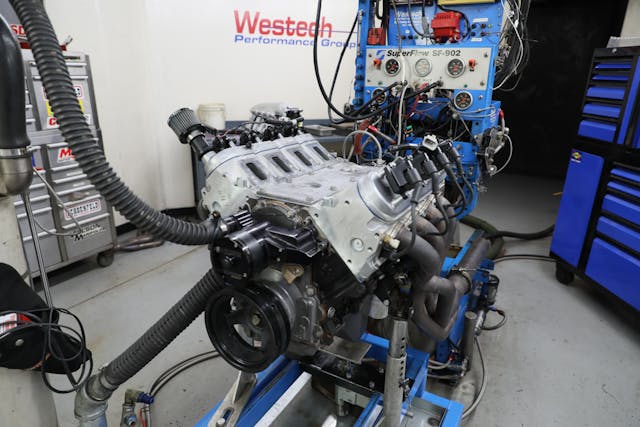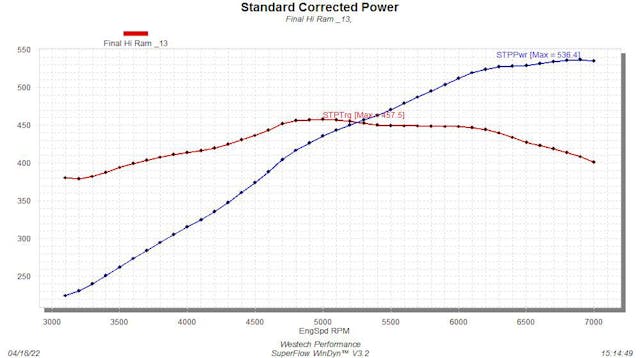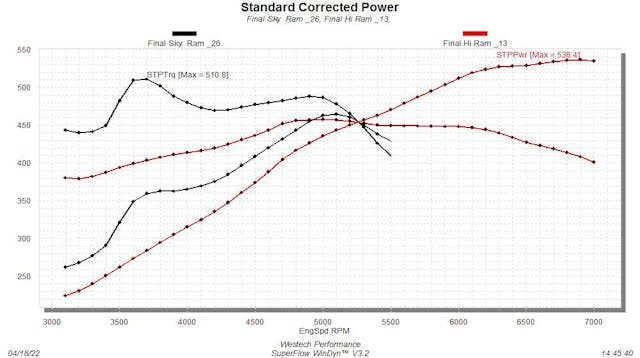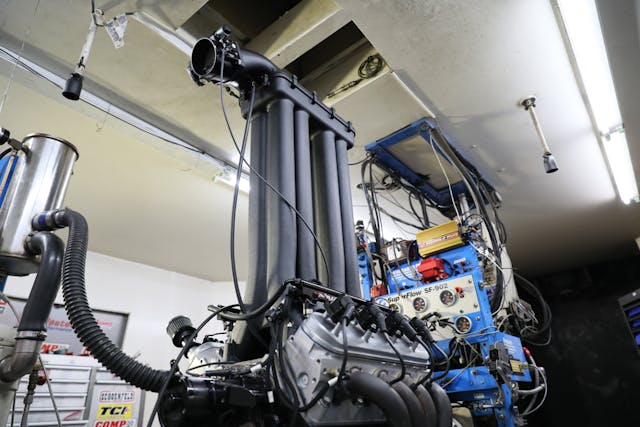Holley’s Sky-Ram intake is a joke, but the real torque figures sure ain’t
For the past few April Fool’s Days, Holley Performance Products has cooked up some great fake products and created some well-produced promo videos to highlight them. For 2022, their bizarre product was an intake manifold with ridiculously long runners. Dubbed Sky-Ram, the manifold was a take on the Hi-Ram, a tunnel ram system that the company builds for several engine families. To make it a true spectacle, Holley stretched the intake port length from just over six-and-a-quarter inches in the Hi-Ram to more than 30 inches in the Sky-Ram! Rather than manipulating a photo or showing a digital rendering of the Sky-Ram for the prank, Holley 3D-printed the lower manifold and finished it to look like a production piece. The hot-rodding community loved it, and comments on YouTube and social media sites called for the engine to hit the dyno. Lucky for them, Holley was already planning to do just that.

Holley brought the Sky-Ram to Westech Performance Group in Jurupa Valley, California, to see just how the mega-tunnel ram would stack up against an off-the-shelf intake. The recipient of the towering manifold was a 6.0-liter GM LS-style V-8 based on an iron LQ9 block. The block is the same one that you’d find in high-output Chevrolet, GMC, and Cadillac SUVs, where they made 345 hp at 10.1:1 compression. This engine ditched its factory, cathedral-port heads in favor of high-flowing LS3-style heads from Engine Quest. Compression was set at 9.8:1 and it was given a free-flowing set of headers and a healthy Comp cam with 227/243 degrees of duration and .613 inch/.623 inch of lift on the intake and exhaust, respectively.

Topped with a production Holley Hi-Ram and warmed up to operating temp, the engine made its baseline dyno pull to have numbers to compare against the Sky-Ram. With Westech’s Steve Brule at the helm, the engine ran smoothly to 7,000 rpm, making 536 horsepower at 6,900 rpm and 457 lb-ft of torque at 5,000 rpm. With 1,900 rpm between peak torque and peak power, this would make a fantastic street or performance engine. The torque curve is incredibly flat. In fact, the engine produced 90 percent or more of its peak torque from about 3700 rpm until just shy of its 6900 rpm power peak.

Baseline data in the bag, the stage was set for the Sky-Ram. With the wild manifold in place and the Holley HP ECU tuned for the new fuel demands, it was time to see whether this monstrosity could deliver. As you can see, it could barely fit in the dyno cell.

Once again, Brule warmed the engine up and made some pulls. The results were impressive.

The Sky-Ram outperformed the off-the-shelf intake all the way to about 5200 rpm but left a lot of power on the table. Peak power was 464.5 hp at 5100 rpm. Peak torque, however, was way up, peaking at a stump-pulling 510.8 lb-ft at just 3700 rpm. That’s the kind of torque curve that would make a muscle-car-era big-block blush. Just take a look at that huge jump in the curve that really comes on 3500 rpm. That’s exactly what a long runner is built to do, and highlights how the length of the runner can be modified to tune the engine speed at which peak torque occurs. How does it do that? The intake charge has momentum as it heads down the runner into the combustion chamber. When the intake valve closes, that charge suddenly stops and creates a pressure wave that heads back to the plenum at the speed of sound. When the pressure wave hits the plenum, it bounces back, sending higher pressure back down the runner toward the intake valve. That pressure wave will bounce back and forth, losing energy each time. Timing the reflection of that pressure wave to the opening of the intake valve can result in increased volumetric efficiency, which is obviously what we’re seeing in the Sky-Ram’s dyno chart.

To put the Sky-Ram’s output into perspective, that’s the same peak torque as an early Duramax diesel V-8, with 10-percent less displacement and 100-percent fewer turbochargers. Granted, it’s also using high-flow headers and no accessories, but it’s still very impressive. For a low-revving application like a truck or boat, the Sky-Ram manifold would actually perform quite well. We might not want to put one on one of our vehicles, but we think the dyno test was well worth Holley’s effort and provided a great visualization of engine theory. Now we’re just wondering what they’re cooking up for next April Fools.


